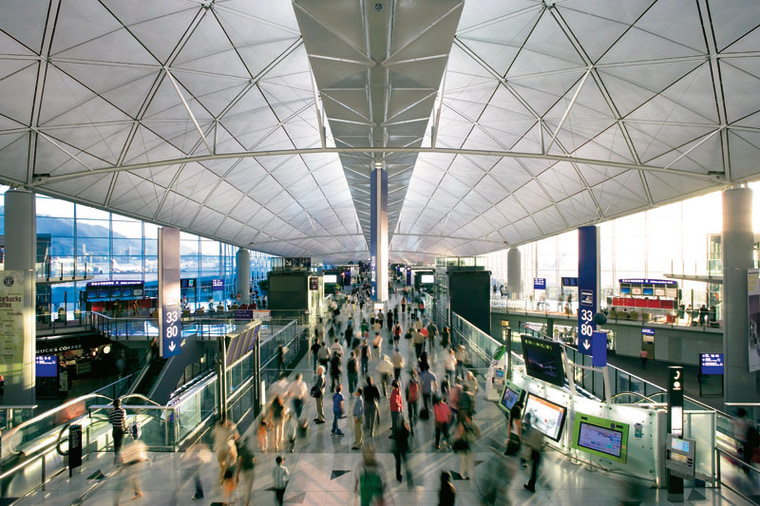Airports are the Great Pyramids of the modern age: These grand architectural monuments express both the pinnacle of human engineering and the frenetic nature of our lives. And, while many passengers pass through the lounge and security screening in the near-catatonic state that modern travel seems to engender, several modern airports—designed by the world's leading architects—demand more than a jet-lagged nod of appreciation. They command attention, respect and quite possibly a stopover.
Behold the biggest building on earth: Beijing Capital International Airport, designed by none other than Sir Norman Foster, covers an area of 14 million square feet. Ludicrous? Maybe. But with 4.8 billion passengers arriving and departing the world's airports in 2007, this monolithic structure may well be the shape and size of things to come.
In the 1950s the humble airport was little more than a shed housing a ticket counter, coffee shop and a waiting area. "People thought the jet age was it, and we designed their airports accordingly," says Kim Day, architect and manager of aviation at Denver International Airport. Then came the '70s, the Boeing 747 and airline entrepreneur Sir Frederick Laker (founder of the first no-frills carrier, Laker Airways) heralding a new era of affordable air travel.
Nowadays the developing world is on the go and nine out of 10 of the fastest growing airports are situated in Asia. Combine that with plentiful cheap labor and it's not surprising that our list of remarkable modern airports attracts substantial representation from the region.
Kim Day sees airports as one of the last great expressions of civic pride. An airport is a grand cultural gateway and clients spare little expense commissioning the most revered architect they can possibly afford. Sir Norman Foster, Santiago Calatrava, Richard Rogers and other luminaries have turned today's airports into welcome mats of masterful design.
Lord Foster describes Beijing City International Airport as communicating "… a uniquely Chinese sense of place … expressed in its dragon-like form and the drama of the soaring roof that is a blaze of 'traditional' Chinese colors…the red columns stretching ahead into the far distance evokes images of a Chinese temple."
Architect Massimiliano Fuksas, who designed the 4.8 million-square-foot Shenzhen Airport in central China, says he finds the sheer scale exciting, but also loves the fact that his building will "mark the history of a city and act as a bridge between East and West."
Even so, with chaotic air traffic, baggage handling, car parking, shopping malls and security, all factors to consider when sketching out a concept, designing an airport is surely the most difficult of all architectural challenges. "An airport has to be able to add or subtract pieces as needed, provide flexible spaces, yet have a clear spatial language in order to allow people to understand where to go when the signage may not be in your native tongue," says Day. Add to that recent challenges such as the introduction of the behemoth Airbus A380 (with a 261-foot wingspan and seating for 800) and designing an airport might actually be an architect's worst nightmare.
However, Alan Grant, owner of Grant architects, a Los Angeles-based firm with extensive expertise in grand public works, sees it differently. "Big projects like this are surprisingly easy because there are so many people involved," he says, adding, "as an architect and cynic of architects, I think we're getting a little too much press. In reality we come up with these beautiful napkin sketches and then the engineers are responsible for making it work."

The biggest design responsibility? "The roof and the lobby space," says Grant. He offers a telling insight into an architect's inner motivation. "They're quite appealing to design because they're grand. To say you designed the world's largest building is a real ego trip. There also tends to be more creative freedom so it's great for the portfolio." (Plus, just quietly, an architect's fee is based on a percentage of the cost of what is often a billion-dollar project.)
The sprawling central terminal of Hong Kong's Chek Lap Kok Airport pays homage to the airplane hangars of old. But when it comes to soaring roofs and a bold vision of the future, the immense Terminal 4 at Barajas Airport in Madrid, Spain, comes to mind, as does—even after 50 years—Eero Saarinen's classic swooping and newly renovated Terminal Five (the old TWA terminal) at New York's JFK.
With jumbo size budgets, revolutionary new materials and adventurous clients, it's no wonder architects are letting their imagination take flight. For design-savvy travelers passing through these grand cathedrals of aviation, a seven-hour layover may not seem so long after all.
